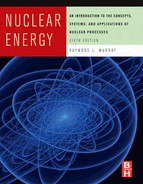Preface
The prospects for continued and new nuclear power plants in the United States have improved greatly since the fifth edition was written. In what is called a nuclear renaissance, many utilities have made application to the Nuclear Regulatory Commission for license extension and approval for new reactor construction. Nuclear reactors are planned that combat global warming, conserve nuclear fuel, support desalination, and produce hydrogen for transportation.
Since the terrorist attacks of September 11, 2001, applications of nuclear processes have become more important. Detectors of nuclear materials entering the United States are being installed, and physical protection of nuclear facilities has been greatly enhanced.
The classical method of collecting information by consultation of books, reports, and articles in a library has been essentially replaced by use of Internet search engines, especially Google. Often, it is more convenient to try search words or phrases instead of typing in the URL of a Web site. The down side of Internet use is the omission of dates of posting, the lack of peer review of Web contents, and the tendency of sites to vanish. These problems are partly balanced by the wealth of information made available conveniently and instantly.
I am convinced that student learning is enhanced by performing calculations on nuclear quantities. The new edition provides Exercises, solvable by hand-held calculator, with Answers to Exercises given in the Appendix.
Computer programs in Qbasic, Excel, and MATLAB for the solution of computer exercises in the text can be found at http://elsevierdirect.com/companions/9780123705471.
For faculty who use the text in an academic course, instructor support materials, including solutions to exercises and PowerPoint slides, are available by registering at http://textbooks.elsevier.com.
As stated in the preface to the first edition (1975), the book “is designed for use by anyone who wishes to know about the role of nuclear energy in our society or to learn nuclear concepts for use in professional work.” I hope that the book will benefit both future nuclear leaders and interested members of the public.
Each of the editions has dealt with events and trends. Included were the need for new and different sources of energy, United States government activities and reorganizations, the Arab oil embargo, the stagnation of nuclear power, the TMI-2 and Chernobyl accidents, the end of the Cold War, growth in applications of radioisotopes and radiation, the persistent nuclear waste problem, continued safe plant operation, and predictions of a brighter nuclear future.
Communication by e-mail ([email protected]) with teachers, students, and other users of the book will be most welcome.
Many persons have provided valuable ideas and information. They are recognized at appropriate places in the book. The author has appreciated the interaction with Dr. Randy J. Jost of Utah State University and welcomes his continued upgrading of computer programs and the creation of slides and other material for use by instructors. Thanks go to Dr. Keith E. Holbert of Arizona State University for his thorough review of the complete manuscript of this book. Special thanks are due Nancy Reid Baker for vital computer support, for preparation of artwork, and for formatting copy to ensure completeness and correctness.
Thanks are due members of the Elsevier team, who provided advice and prepared the text for publication—Joseph Hayton, Publisher; Maria Alonso, Assistant Editor; Eric DeCicco, Senior Designer; Anne McGee, Production Manager; and Suja Narayana, Project Manager.
I appreciated encouragement by my wife, Elizabeth Reid Murray.
